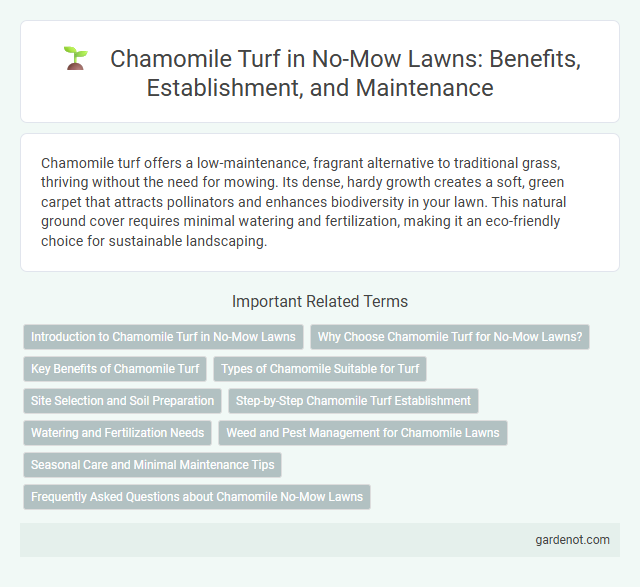Chamomile turf offers a low-maintenance, fragrant alternative to traditional grass, thriving without the need for mowing. Its dense, hardy growth creates a soft, green carpet that attracts pollinators and enhances biodiversity in your lawn. This natural ground cover requires minimal watering and fertilization, making it an eco-friendly choice for sustainable landscaping.
Introduction to Chamomile Turf in No-Mow Lawns
Chamomile turf offers a fragrant and resilient alternative to traditional grass in no-mow lawns, thriving without the need for regular mowing or maintenance. Its low growth habit and drought tolerance make it well-suited for sustainable landscaping, promoting biodiversity and reducing water usage. This versatile ground cover not only enhances lawn aesthetics but also supports pollinators, creating an eco-friendly outdoor space.
Why Choose Chamomile Turf for No-Mow Lawns?
Chamomile turf offers a low-maintenance, drought-tolerant alternative to traditional grass, ideal for no-mow lawns. Its fine, aromatic leaves create a soft, green carpet that requires minimal watering and virtually no mowing, reducing lawn care time and costs. Rich in natural pest resistance and capable of thriving in poor soil conditions, chamomile turf promotes eco-friendly, sustainable landscaping.
Key Benefits of Chamomile Turf
Chamomile turf offers natural weed suppression and enhances soil health through its dense, low-growing foliage that requires minimal mowing. Its drought tolerance and pest-resistant properties reduce maintenance efforts while promoting a lush, fragrant lawn ideal for eco-friendly landscapes. This resilient turf supports biodiversity by attracting pollinators, making it an excellent choice for sustainable gardening.
Types of Chamomile Suitable for Turf
Chamomile turf primarily utilizes Roman chamomile (Chamaemelum nobile) and sometimes German chamomile (Matricaria chamomilla) for ground cover due to their low growth habit and aromatic qualities. Roman chamomile offers dense, carpet-like coverage and tolerance to light foot traffic, making it ideal for no-mow lawns. German chamomile, while less common, provides rapid growth and enhanced weed suppression but requires slightly more maintenance to maintain turf aesthetics.
Site Selection and Soil Preparation
Chamomile turf thrives best in well-drained, sandy loam soils with a slightly acidic to neutral pH between 6.0 and 7.0, ensuring optimal growth and resilience. Selecting a sunny location with at least 6 hours of direct sunlight daily promotes dense, healthy coverage and enhances the plant's natural pest resistance. Proper soil preparation involves loosening the top 6-8 inches to improve aeration and incorporating organic matter such as compost to enrich fertility and moisture retention.
Step-by-Step Chamomile Turf Establishment
Prepare the soil by loosening it to a fine tilth and removing any existing grass or weeds to ensure optimal chamomile turf establishment. Sow chamomile seeds evenly at a rate of 10-15 grams per square meter, lightly covering them with a thin layer of soil to promote germination. Maintain consistent moisture by watering gently but thoroughly, allowing seedlings to establish over 4-6 weeks before reducing irrigation frequency.
Watering and Fertilization Needs
Chamomile turf requires minimal watering, thriving in well-drained soil with moderate moisture levels, making it an ideal low-maintenance no-mow lawn option. Fertilization needs are low, with occasional application of balanced, slow-release fertilizers supporting healthy growth without promoting excessive lushness. This drought-tolerant plant benefits from nutrient-rich soil but avoids heavy fertilization to maintain its natural, compact form.
Weed and Pest Management for Chamomile Lawns
Chamomile turf naturally suppresses weed growth through its dense, aromatic foliage, creating an inhospitable environment for common lawn weeds. Its essential oils act as a natural pest deterrent, reducing the need for chemical pesticides while maintaining a healthy lawn ecosystem. Effective weed and pest management in chamomile lawns relies on proper soil preparation and periodic monitoring to sustain its natural protective benefits.
Seasonal Care and Minimal Maintenance Tips
Chamomile turf thrives with minimal watering, benefiting from occasional light trimming to maintain its low-growing habit and promote dense coverage. Seasonal care involves mowing just once or twice a year in early spring and late fall to remove any dead or overgrown stems, enhancing its fresh appearance. Applying organic mulch around the edges helps retain moisture and suppress weeds, supporting the turf's natural resilience and reducing maintenance needs.
Frequently Asked Questions about Chamomile No-Mow Lawns
Chamomile no-mow lawns thrive in well-drained soil with full sun exposure, requiring minimal maintenance compared to traditional grass turf. These lawns naturally resist pests and weeds, reducing the need for chemical treatments and frequent watering. Homeowners often ask about chamomile's durability in high-traffic areas and learn it remains soft yet resilient, making it ideal for eco-friendly, low-maintenance landscapes.
Chamomile turf Infographic

 gardenot.com
gardenot.com